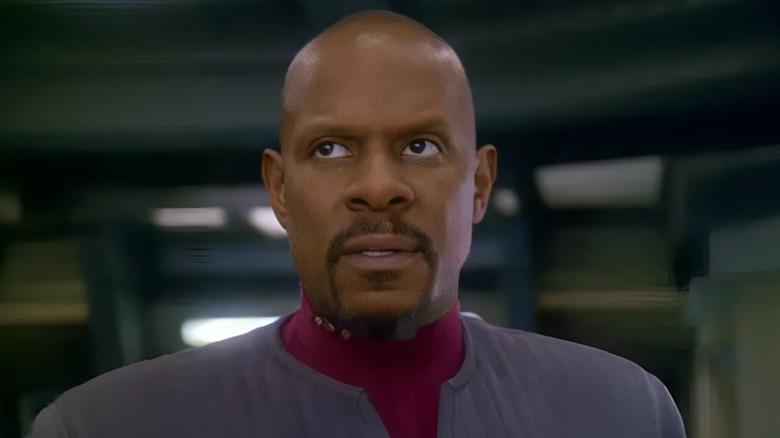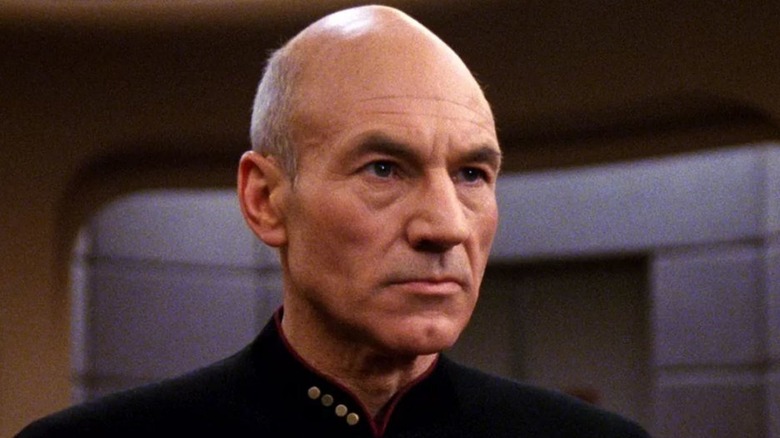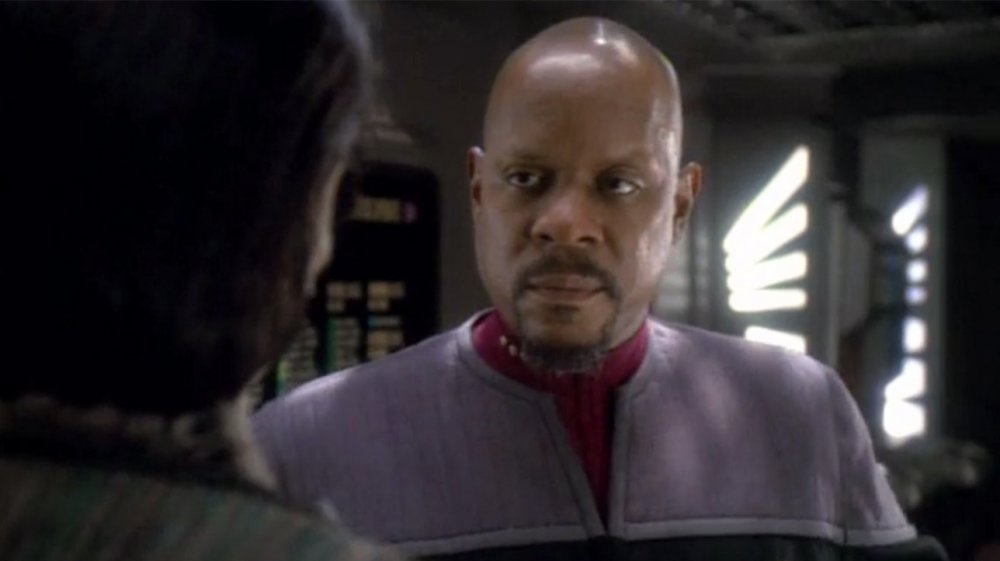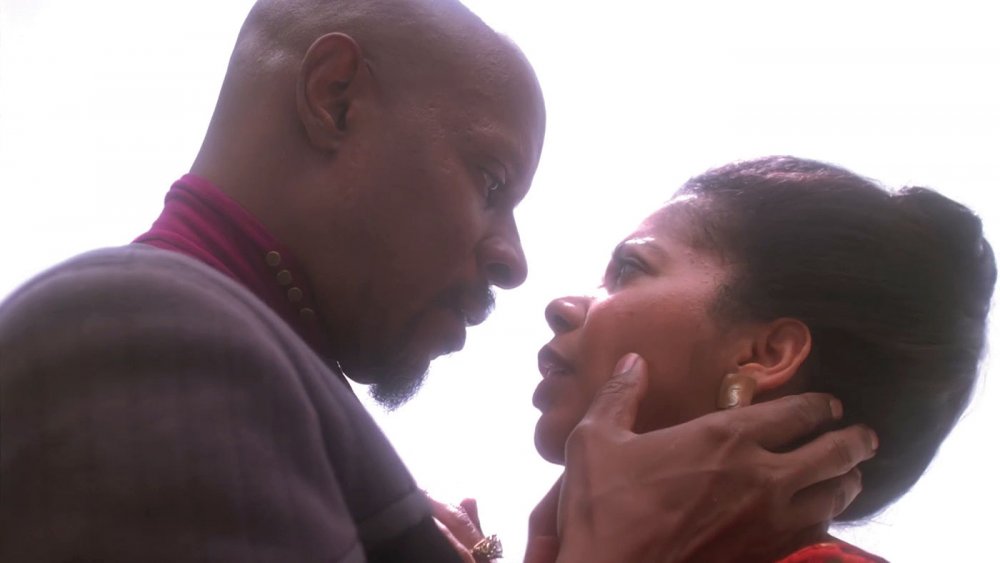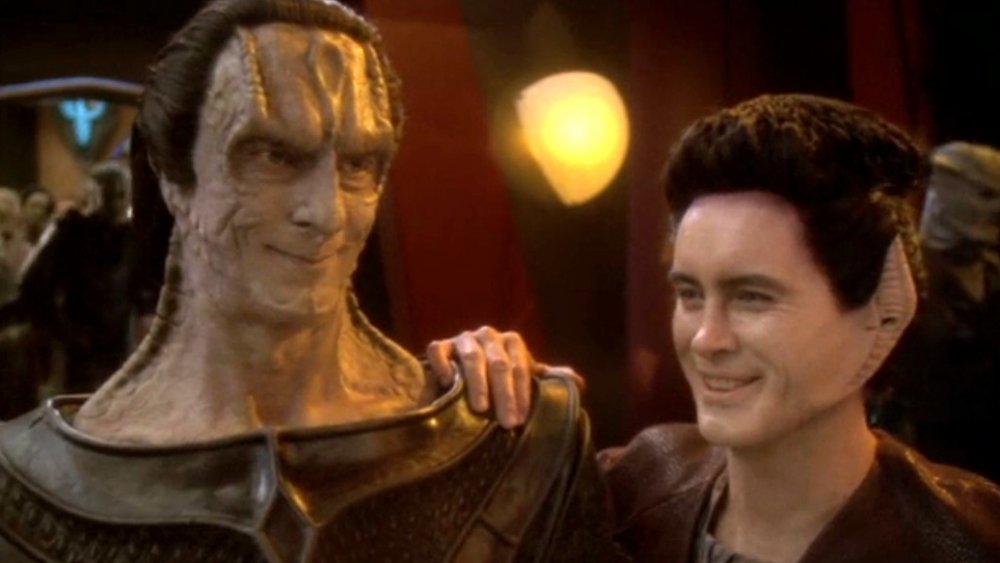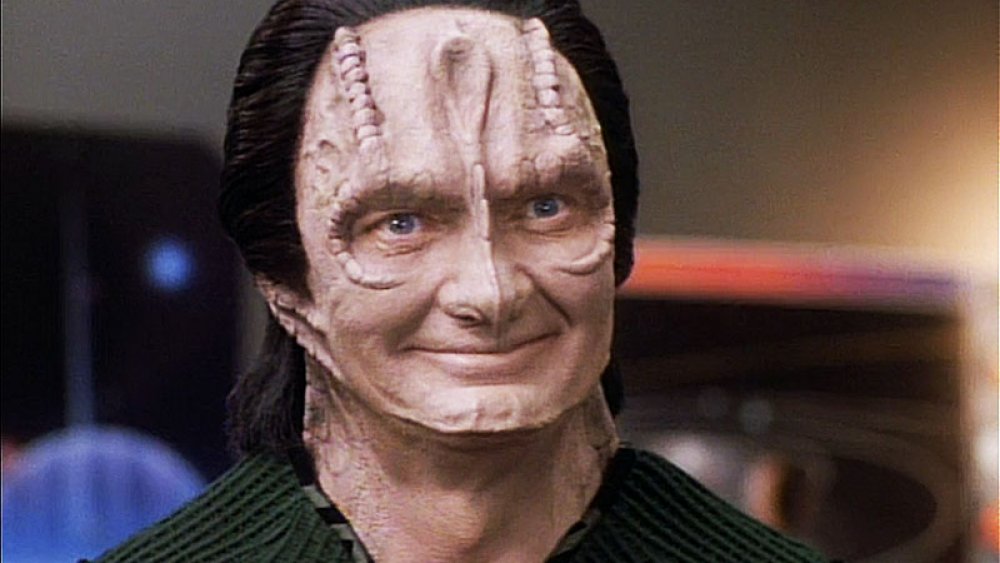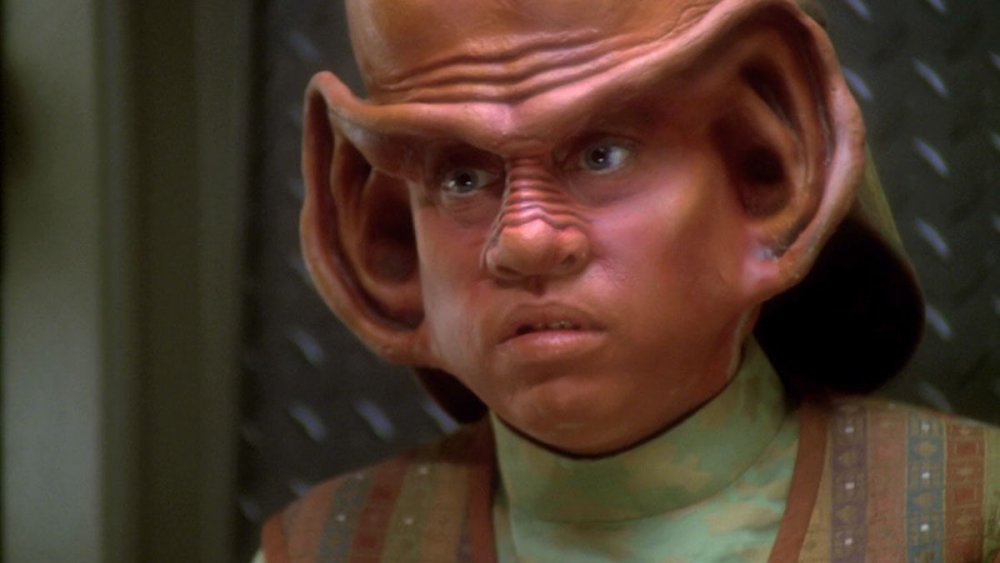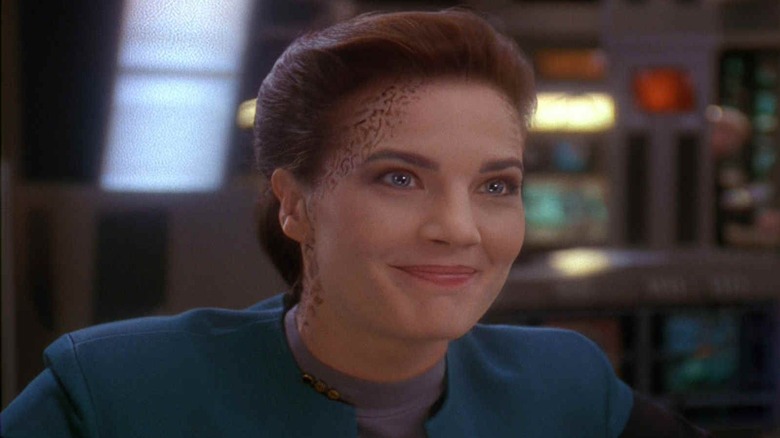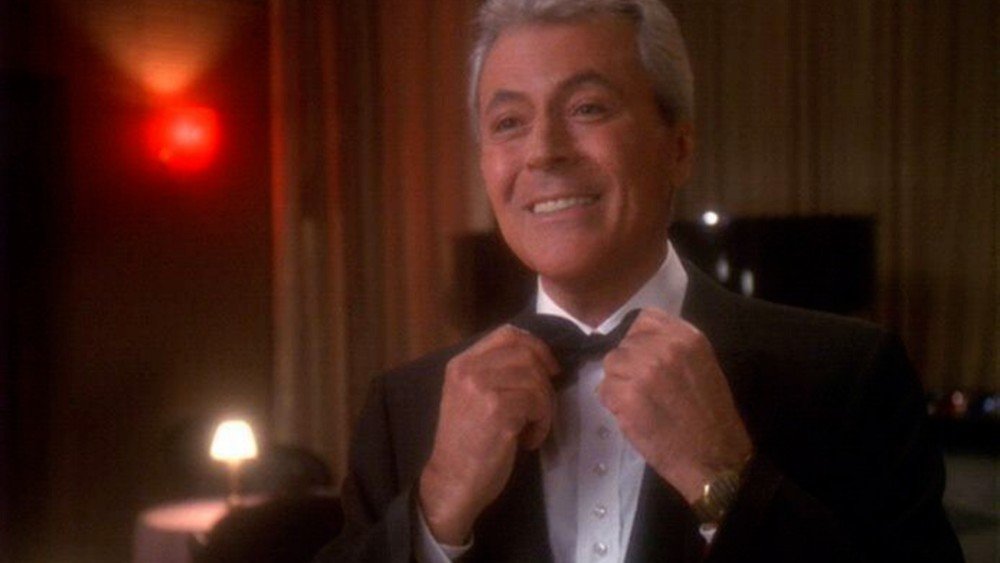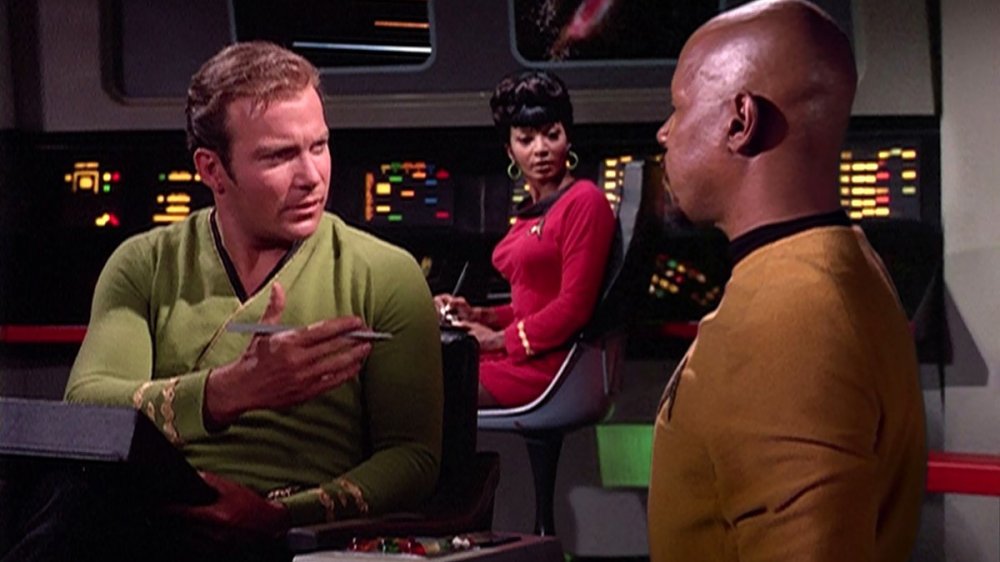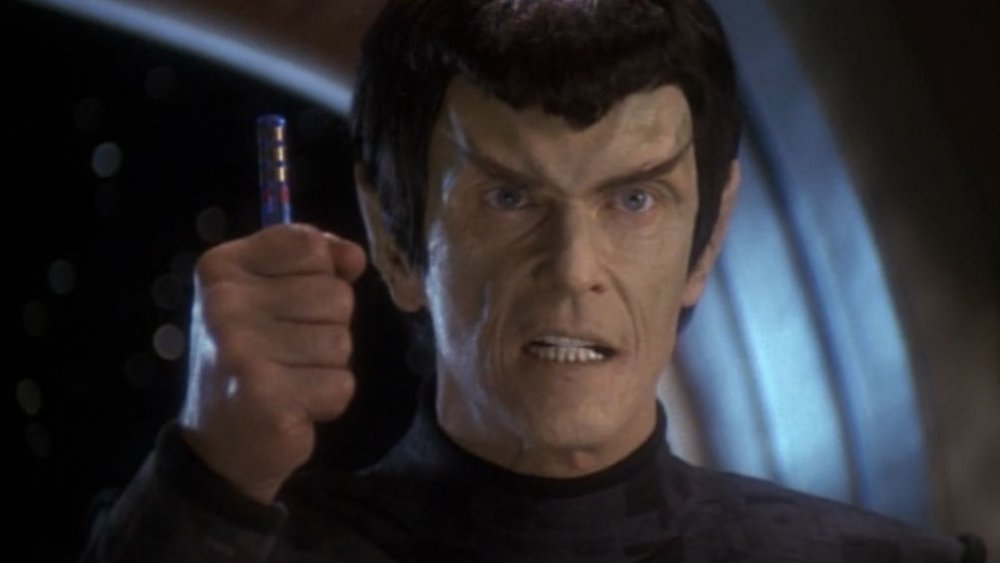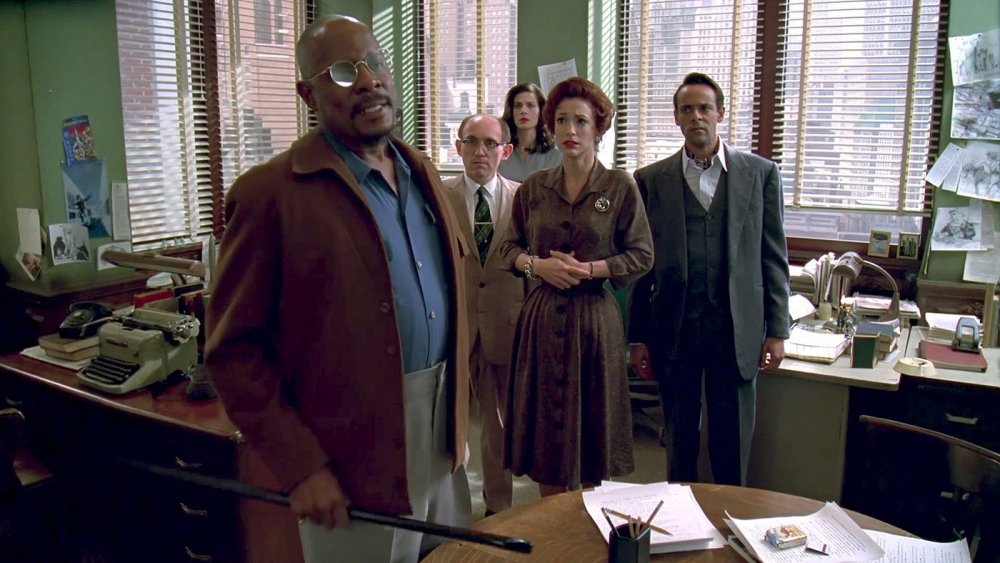The Untold Truth Of Star Trek: Deep Space Nine
In 1987 Patrick Stewart led a cast into the stars with Star Trek: The Next Generation (TNG) – the first live-action Trek television series since Star Trek: The Original Series (TOS) was canceled in 1969. TNG breathed new life into the franchise and the producers decided it was time to expand. In 1993 — a year before TNG's series finale – Star Trek: Deep Space Nine (DS9) premiered with the two-part "Emissary."
DS9's lead doesn't have lofty dreams of space exploration. Benjamin Sisko (Avery Brooks) is a single father and a widower when he's assigned as Commander to the Bajoran space station. Initially resistant to the posting, Sisko eventually accepts it in spite of finding himself in the uncomfortable and unwanted position of becoming a religious icon to the Bajorans.
Ironically while DS9's story focus has little to do with space exploration, in many ways it goes where none of the Trek series of its time dared to even consider traveling. Along with being the first Trek series to cast a person of color in the lead role, DS9 focuses more on the people "boldly going" than where they're going. As a result, the characters of DS9 come alive in ways you don't see elsewhere in the franchise, and in particular DS9 allows a level of moral ambiguity almost unheard of in the world Gene Roddenberry built.
To learn more about how this landmark series came to be, keep reading for the untold truth of Star Trek: Deep Space Nine.
Star Trek: The Middle Child
When DS9 premiered, TNG was still on the air; less than a year after TNG ended, Star Trek: Voyager showed up. Because of this, in the 2018 DS9 documentary What We Left Behind, multiple cast and crew members use similar terms to describe the negative reactions DS9 received from fans of the time — they call the show the Star Trek "middle brother" or "middle child." Ben Sisko and his station's crew only got a couple of episodes at the end of DS9's second season and the first half of its third without another more traditional Trek series outshining it.
Throughout the documentary, we catch snippets of actors reading printouts of angry fan complaints about the show. Some of the more frequent argue that the show is darker than other Trek series and that — unlike the shows that focused on exploration — the cast of DS9 mostly just hung out on a space station.
In a 2002 chat at StarTrek.com (via TrekToday), Andrew Robinson — who played the recurring character Garak — said he thought DS9 suffered in popularity because things weren't quite so black-and-white on the series. "[DS9 is] not the most popular because it's the most morally ambiguous," Robinson responded to another chat attendee. "Whenever you have characters who are gray rather than black and white... Although they are more interesting, they are more difficult for people to get a handle on."
Serialization before it was cool
In the early '90s, television storytelling was largely episodic. For most shows, each episode was written to be self-contained so that anyone could tune in and follow the story. Trek series were no different at first, but DS9 broke the mold.
DS9 opens its second season with a three-part episode. While TNG had occasionally indulged in two-parters like the popular "Best of Both Worlds" that sees Captain Picard assimilated by the Borg, before DS9's second season, a three-part episode was unheard of for Trek.
The Federation's war with the evil Dominion opened up even more possibilities. In the early seasons, mention of the Dominion is sprinkled in random episodes to build curiosity. Open war breaks out in the season 5 finale "Call to Arms" when the Dominion captures the station, and the heroes don't take their home back until the end of the following season's sixth episode. Likewise, DS9 ends with an epic 10-part story that sees the conclusion of the Dominion War.
Many feel that not only was DS9 an early pioneer in our current love affair with serialization, but that this is the reason the series is more popular now than it was while the show was in production. Streaming services like Netflix give viewers a chance to binge and appreciate the more serialized format. "The show is the same exact show," showrunner Behr says on What We Left Behind. "Nothing has changed. What's changed is the delivery system."
DS9 put people of color front and center
On What We Left Behind, we see a clip from CNN's The Nineties in which a commentator mentions the police detective series Homicide: Life on the Street and how there were so many African-Americans in the show's cast that often they were the only people on screen. The commentator tells us "As late as the '90s," having no one but African-Americans on screen simply "wasn't done." The comment angers DS9 showrunner Ira Steven Behr, and it's tough to blame him.
DS9 was innovative when it came to the representation of people of color, and not just because the obvious reason that it featured an African-American lead. In spite of the claim of The Nineties' commentator, it wasn't remotely uncommon to see nothing but people of color in a scene of DS9. In particular, we often see scenes between Ben Sisko and his son Jake, played by Cirroc Lofton. Providing a positive role model for African-American fathers and sons was intensely important to Avery Brooks. They're often joined by Ben's love interest Kasidy Yates (Penny Johnson Jerald) and father Joseph (Brock Peters).
Likewise on the sixth season DS9 box set, Alexander Siddig spoke about how excited he was when he was cast as one of the series regulars, in spite of being racially difficult to identify for most viewers.
DS9 had an extended family of recurring characters
One of the wonderful benefits of DS9's stronger focus on serialization is that it has a much larger group of recurring characters than any Trek series before or since. One of the most visible is the Cardassian villain Gul Dukat. Played by Marc Alaimo, Dukat begins as a power-hungry Cardassian officer in the DS9 premiere; by the series finale he's gone over the deep end and become the host to a devilish Pah-wraith.
In spite of her character dying in the first episode, Felecia Bell keeps popping up as Ben Sisko's late wife Jennifer. Initially meant only for a couple of episodes, J.G. Hertzler played the Klingon General Martok well enough that he's a fixture on DS9 between the middle of its fifth season to the conclusion. And occasionally the scheming bartender Quark (Armin Shimmerman) would be visited by the head of the Ferengi government — the Grand Nagus, played by Wallace Shawn (best known as the Sicilian mastermind Vizzini from The Princess Bride).
But the undisputed king of DS9's recurring cast is Jeffrey Alan Combs. Combs first shows up as a wealthy alien obsessed with Kira in Season 3's "Meridian." He would later be cast as two of DS9's recurring villains. Combs plays the Ferengi Liquidator Brunt who constantly hounds Quark and his family, and later he's cast as the always smiling and always scheming Weyoun — the Dominion's chief diplomat in charge of the war against the Federation.
Plain, simple Garak
Since DS9's surge in popularity years after the finale, it's become clear that many of the newer fans have the same answer when you ask them who their favorite character is: Garak, played by Andrew Robinson. Introduced in season 1's "Past Prologue," Garak is easily the most mysterious of all the recurring or regular characters on the series. When he introduces himself to Dr. Bashir, he insists he is "plain, simple" Garak — a tailor with a perfectly mundane past. As the series unfolds, we learn he was a former member of the Obsidian Order — the Cardassian Empire's secret police — who was exiled to Deep Space Nine.
We learn a few other important details about Garak throughout the series, but never quite as much as we want. We never learn, for example, why he's exiled to DS9. In season 2's "The Wire," the Cardassian gives Bashir plenty of different versions of why he was exiled, though we never learn which story — if any — is true. In spite of all the evidence he shows to the contrary, for much of the series Garak continues to protest any implications that he's anything but a simple tailor.
As what he called an "acting exercise," Robinson began writing his own version of Garak's history. The actor said that soon "it became an obsession." As a result, Robinson's novel A Stitch in Time – telling Garak's life story — hit shelves in May 2000.
The Ferengi who changed
Star Trek characters aren't known for their capacity for change. Overall DS9 is different from most Trek series in this way, and no character on DS9 – and arguably in the entire Trek franchise — changes more than the young Ferengi Nog.
When we first meet Nog (Aron Eisenberg), he and an older alien are stealing from an abandoned Bajoran shop. For most of the earlier seasons he's Jake Sisko's closest friend, though the influence of Quark doesn't help his reputation. He often pulls mean pranks on the station's Bajoran residents and adopts his race's more sexist and cowardly tendencies.
Eventually, Nog shocks Ben Sisko by begging for Sisko's help to get into Starfleet Academy. Deeply affected by the example of his father Rom (Max Grodénchik) — who, though an engineering prodigy, is stuck working for Quark at the bar — Nog means to buck Ferengi norms and make something of himself regardless of profit. He becomes a proud (sometimes overbearingly so) Starfleet cadet and a brave officer.
In DS9's final season Nog undergoes his most starling change. In "The Siege of Ar-558," Nog loses his leg after he's wounded in a Jem'Hadar ambush. Two episodes later in "It's Only a Paper Moon," Nog returns to DS9 with a prosthetic leg and suffering from PTSD. Pushing away his friends and family, Nog seeks refuge in Vic Fontaine's (James Darren) Las Vegas holosuite program, though the sentient holo-character eventually convinces the suffering Ferengi to return to the real world.
The old man
Jadzia Dax (Terry Farrell) is a Trill. Trill are a symbiotic species, some of whose members are comprised of the mixing of two beings — a humanoid host and a small, slug-like symbiont that lives in the humanoid's torso. When the humanoid dies, a new host is found for the symbiont. Since both symbiont and host are two distinct beings, each new host/symbiont combo becomes a brand new person while still carrying the memories of previous joinings.
The concept leads to some interesting stories on DS9. Among other things, it opened the doors for one of the earliest same-gender kisses on television. Reunited with a previous, male host's wife in season 4's "Rejoined," Dax and Lenara (Susanna Thompson) rekindle their old romance in spite of the Trill taboo against reconnecting with previous hosts' loved ones.
Unfortunately, it also allowed for Farrell's early departure from DS9. Jadzia is murdered in the season 6 finale. Different versions of what happened have been told over the years, but the crux appears to be that contract negotiations broke down between Farrell and the studio. In a 2011 interview with Farrell at StarTrek.com, she talked largely about being tired of the demanding work schedule. However, later on What We Left Behind, Farrell and others make references to tensions between her and the producers, including one unnamed producer who — according to Farrell — told her she should agree to whatever the studio offered her because if she wasn't at DS9 she'd be "working at K-Mart."
He wasn't bad for a lightbulb
At the end of season 4, DS9 introduces Vic Fontaine, played by former teen heartthrob James Darren. Vic is a holographic character in a holosuite program set in 1960s Las Vegas. For reasons that are never fully explained, Vic is sentient. He knows he's a hologram and acts as a font of wisdom to DS9's characters. He helps Nog recover from PTSD, helps to finally bring Kira and Odo together in "His Way," and in the series finale, he sings a touching rendition of Frank Sinatra's "The Way You Look Tonight" to mark the characters' final evening together.
In Terry Erdman and Paula Block's Star Trek: Deep Space Nine Companion, Ira Steven Behr claims that Vic shows up much later than the showrunner hoped. He first conceived of the character in season 4 and wanted Frank Sinatra, Jr., who Behr said was a big DS9 fan, for the role. When the singer responded that he would rather play an alien, Behr shelved the idea.
On What We Left Behind, Darren says he used a somewhat sneaky tactic in his audition. Rather than doing a cold reading of the dialogue, Darren simply talked to Behr and — as if it were casual conversation — said slightly altered versions of his written lines, surprising Behr each time at what the writer thought was coincidence. Once he realized what Darren was doing, the fact that the actor was "pulling his leg" didn't dissuade Behr from the notion that Darren was the perfect choice.
Trials and Tribble-ations
Time travel is a staple of Star Trek. In fact, when the season 5 episode "Trials and Tribble-ations" aired, all the heroes of the Trek franchise were bouncing through time. That same month, both Star Trek: Voyager's "Future's End" and the TNG film Star Trek: First Contact dealt heavily with time travel. But "Trials and Tribble-ations" did something that had never been seen before in Trek.
Using technology similar to that which put Tom Hanks in scenes with deceased presidents and pop stars in Forrest Gump two years earlier, "Trials and Tribble-ations" deposited DS9's heroes into 1967's "Trouble with Tribbles" episode of TOS. Ben Sisko and Miles O'Brien (Colm Meaney) actually talk to Captain Kirk (William Shatner). O'Brien, Bashir, and Worf (Michael Dorn) join in the earlier episode's goofy barroom brawl, and a hilarious exchange between the heroes addresses the striking differences between the Klingons of DS9 and those of TOS.
On a deleted scene for What We Left Behind, producers Ronald D. Moore and René Echevarria remember visual effects supervisor Gary Hutzel bringing them a scene from "Trouble with Tribbles," and the producers watching it without understanding why Hutzel was showing it to them. When Hutzel rewound the scene and played it again, he pointed out a visual effects employee standing off to the side — wearing a uniform bought at a Trek convention — and the producers hadn't even noticed him the first time they watched.
In the Pale Moonlight
Making regular appearances not only on lists of the best episodes of DS9 but on those choosing the best episodes of the entire franchise is season 6's "In the Pale Moonlight." Tapping deeper than ever into the moral ambiguity that helps set DS9 apart from other Trek shows, the episode sees Ben Sisko and Garak conspiring to fool the Romulan Empire into joining the war against the Dominion.
The episode is told in flashback as Sisko relates the events in a log entry. The plan that Starfleet approves — to create a false holographic recording of Dominion leaders planning the invasion of Romulus — is bad enough, but things progress even further. When the Romulan senator Vreenak discovers the recording is fake, we learn Garak's plan the entire time has been to assassinate the Romulan in an explosion and blame it on the Dominion. In spite of Sisko figuring it out and Garak confessing to his crimes, for the first time on Trek, the ends justify the means. The Romulans join forces with the good guys and rather than expose the deception, the episode ends with Sisko deleting the log entry.
Speaking to Star Trek Magazine (via StarTrek.com) in 2019, Andrew Robinson said the episode "exposes the American innocence, that we want to do these things in the world, but we're not really willing to take the consequences of our actions... sometimes we have to do very dirty things, and we have to hurt people, and we pretend that that doesn't exist."
Far Beyond the Stars
One of DS9's most powerful, acclaimed, and socially poignant episodes is season 6's "Far Beyond the Stars," directed by Avery Brooks. A very different kind of time travel takes place in the episode; rather than transporting the crew to another time or to an earlier story, "Far Beyond the Stars" reimagines the cast as characters in 1950s New York City. Avery Brooks plays Benny Russell, a science fiction writer who writes the story of Deep Space Nine but can't get it published because its lead is African-American. Rene Auberjonois plays editor Douglas Pabst who's squashing Benny's work, a few of the other actors play writers working with Benny, and the usual villains Weyoun and Dukat are transformed into abusive, racist police detectives.
Toward the end of the episode, Benny Russell collapses after an emotional confrontation with Pabst. On What We Left Behind, Nana Visitor said that what we see on the screen is more than just acting. Diving deep into his character, it took Avery Brooks a long time to emerge from Benny Russell's breakdown. "They called 'cut,' and he's not coming out," Visitor said. "I know how that feels like as an actor. You're gone, and he was... he was gone." First Assistant Director Lou Race added, "If I'd stood there for a half hour, I think he would've kept on."
